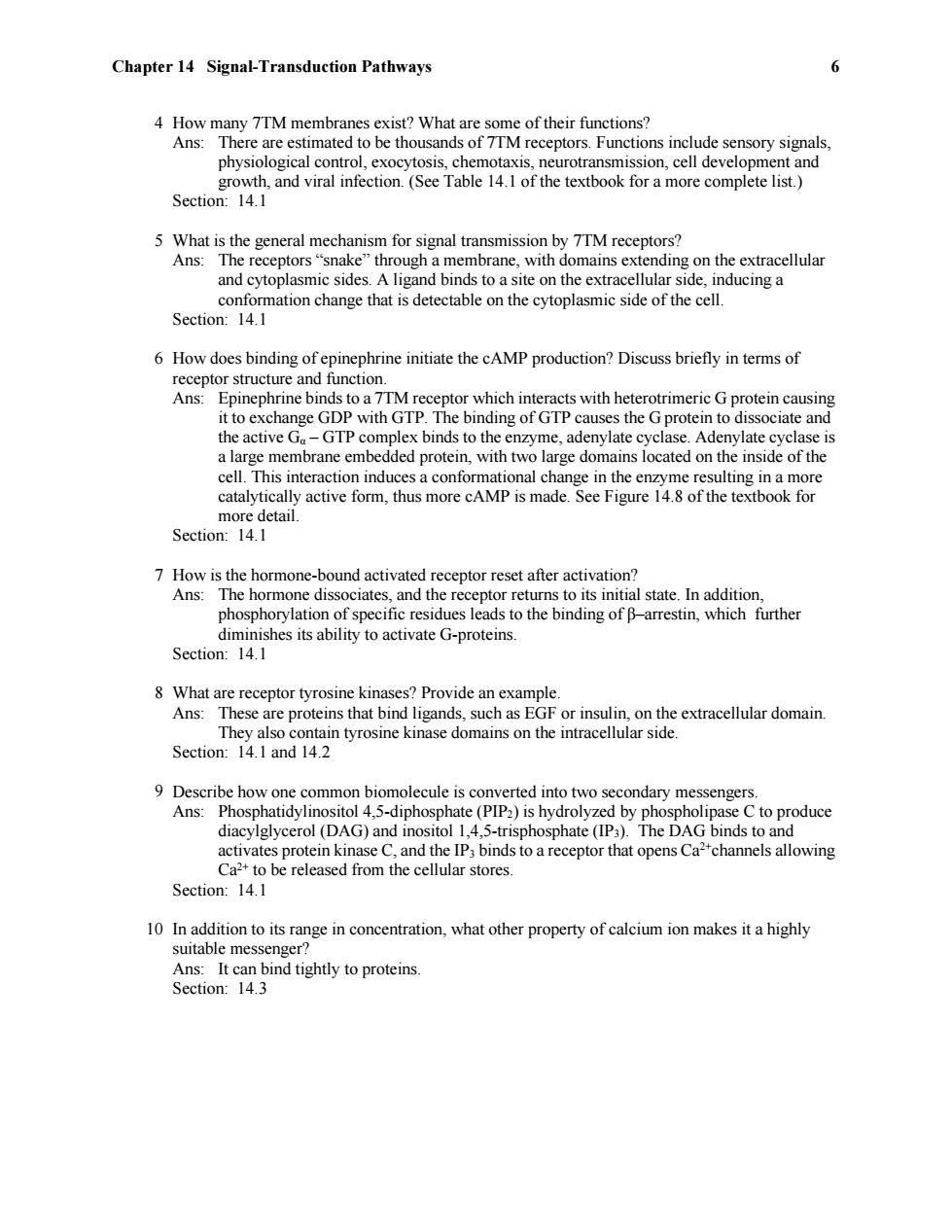正在加载图片...

Chapter 14 Signal-Transduction Pathways 6 4 How many 7TM membranes exist?What are some of their functions? Ans:There are estimated to be thousands of 7TM receptors.Functions include sensory signals, physiological control,exocytosis,chemotaxis,neurotransmission,cell development and growth,and viral infection.(See Table 14.1 of the textbook for a more complete list.) Section:14.1 5 What is the general mechanism for signal transmission by 7TM receptors? Ans:The receptors"snake"through a membrane,with domains extending on the extracellular and cytoplasmic sides.A ligand binds to a site on the extracellular side,inducing a conformation change that is detectable on the cytoplasmic side of the cell. Section:14.1 6 How does binding of epinephrine initiate the cAMP production?Discuss briefly in terms of receptor structure and function. Ans:Epinephrine binds to a 7TM receptor which interacts with heterotrimeric G protein causing it to exchange GDP with GTP.The binding of GTP causes the G protein to dissociate and the active Ga-GTP complex binds to the enzyme,adenylate cyclase.Adenylate cyclase is a large membrane embedded protein,with two large domains located on the inside of the cell.This interaction induces a conformational change in the enzyme resulting in a more catalytically active form,thus more cAMP is made.See Figure 14.8 of the textbook for more detail. Section:14.1 7 How is the hormone-bound activated receptor reset after activation? Ans:The hormone dissociates,and the receptor returns to its initial state.In addition, phosphorylation of specific residues leads to the binding of B-arrestin,which further diminishes its ability to activate G-proteins. Section:14.1 8 What are receptor tyrosine kinases?Provide an example. Ans:These are proteins that bind ligands,such as EGF or insulin,on the extracellular domain. They also contain tyrosine kinase domains on the intracellular side. Section:14.1 and 14.2 9 Describe how one common biomolecule is converted into two secondary messengers. Ans:Phosphatidylinositol 4,5-diphosphate(PIP2)is hydrolyzed by phospholipase C to produce diacylglycerol(DAG)and inositol 1,4,5-trisphosphate(IP3).The DAG binds to and activates protein kinase C,and the IP3 binds to a receptor that opens Ca2*channels allowing Ca2+to be released from the cellular stores. Section:14.1 10 In addition to its range in concentration,what other property of calcium ion makes it a highly suitable messenger? Ans:It can bind tightly to proteins. Section:14.3Chapter 14 Signal-Transduction Pathways 6 4 How many 7TM membranes exist? What are some of their functions? Ans: There are estimated to be thousands of 7TM receptors. Functions include sensory signals, physiological control, exocytosis, chemotaxis, neurotransmission, cell development and growth, and viral infection. (See Table 14.1 of the textbook for a more complete list.) Section: 14.1 5 What is the general mechanism for signal transmission by 7TM receptors? Ans: The receptors “snake” through a membrane, with domains extending on the extracellular and cytoplasmic sides. A ligand binds to a site on the extracellular side, inducing a conformation change that is detectable on the cytoplasmic side of the cell. Section: 14.1 6 How does binding of epinephrine initiate the cAMP production? Discuss briefly in terms of receptor structure and function. Ans: Epinephrine binds to a 7TM receptor which interacts with heterotrimeric G protein causing it to exchange GDP with GTP. The binding of GTP causes the G protein to dissociate and the active Gα – GTP complex binds to the enzyme, adenylate cyclase. Adenylate cyclase is a large membrane embedded protein, with two large domains located on the inside of the cell. This interaction induces a conformational change in the enzyme resulting in a more catalytically active form, thus more cAMP is made. See Figure 14.8 of the textbook for more detail. Section: 14.1 7 How is the hormone-bound activated receptor reset after activation? Ans: The hormone dissociates, and the receptor returns to its initial state. In addition, phosphorylation of specific residues leads to the binding of β–arrestin, which further diminishes its ability to activate G-proteins. Section: 14.1 8 What are receptor tyrosine kinases? Provide an example. Ans: These are proteins that bind ligands, such as EGF or insulin, on the extracellular domain. They also contain tyrosine kinase domains on the intracellular side. Section: 14.1 and 14.2 9 Describe how one common biomolecule is converted into two secondary messengers. Ans: Phosphatidylinositol 4,5-diphosphate (PIP2) is hydrolyzed by phospholipase C to produce diacylglycerol (DAG) and inositol 1,4,5-trisphosphate (IP3). The DAG binds to and activates protein kinase C, and the IP3 binds to a receptor that opens Ca 2+channels allowing Ca 2+ to be released from the cellular stores. Section: 14.1 10 In addition to its range in concentration, what other property of calcium ion makes it a highly suitable messenger? Ans: It can bind tightly to proteins. Section: 14.3